|
RECENT ENTRIES |
- • Cassini's continued mission - 04.20
- • Scenes from the zoo - 04.17
- • Documenting the return of U.S. war dead - 04.15

| October 24, 2008 | (Use j/k keys to navigate) |
Enceladus up close
Saturn's
tiny, icy moon Enceladus has recently been visited by NASA's Cassini
orbiter on several very close approaches - once coming within a mere 25
kilometers (15 miles) of the surface. Scientists are learning a great
deal about this curious little moon. Only about 500 kilometers wide
(310 miles), it is very active, emitting internal heat, churning its
surface, and - through cryovolcanism - ejecting masses of microscopic
ice particles into Saturnian orbit. Cassini has been orbiting Saturn
for over 4 years now, and has provided some amazing views of tiny
Enceladus, some collected here. Another close flyby is scheduled for
Halloween, October 31st. (26 photos total)
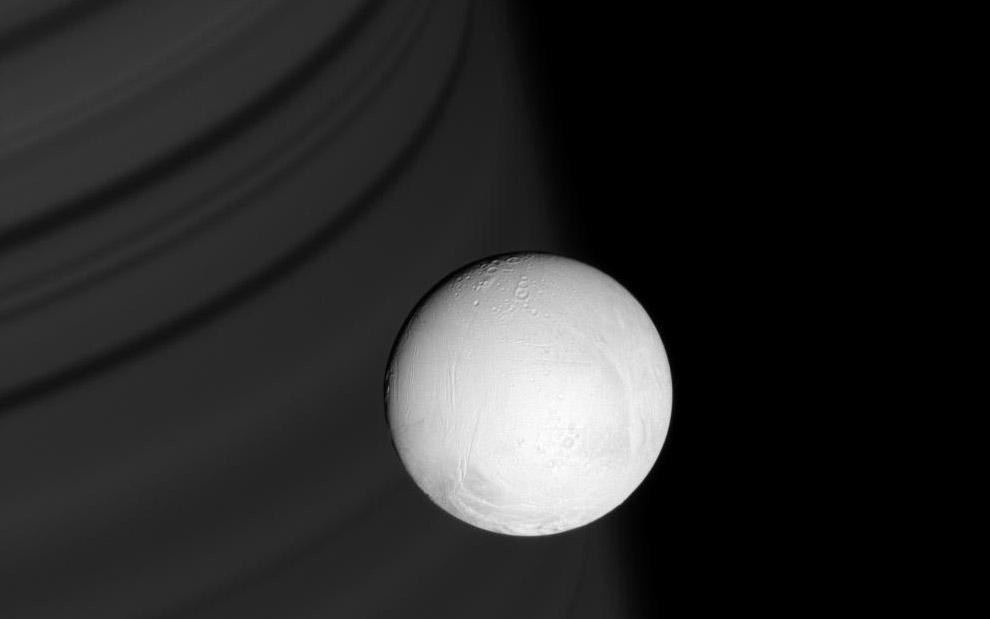
Ring
shadows line the face of distant Saturn, providing a backdrop for the
brilliant, white sphere of Enceladus. This image looks toward the
leading side of Enceladus. North is up. The image was taken in visible
green light with the Cassini spacecraft narrow-angle camera on June 28,
2007. The view was acquired at a distance of approximately 291,000
kilometers (181,000 miles) from Enceladus. Image scale is 2 kilometers
(1 mile) per pixel. (NASA/JPL-Caltech)
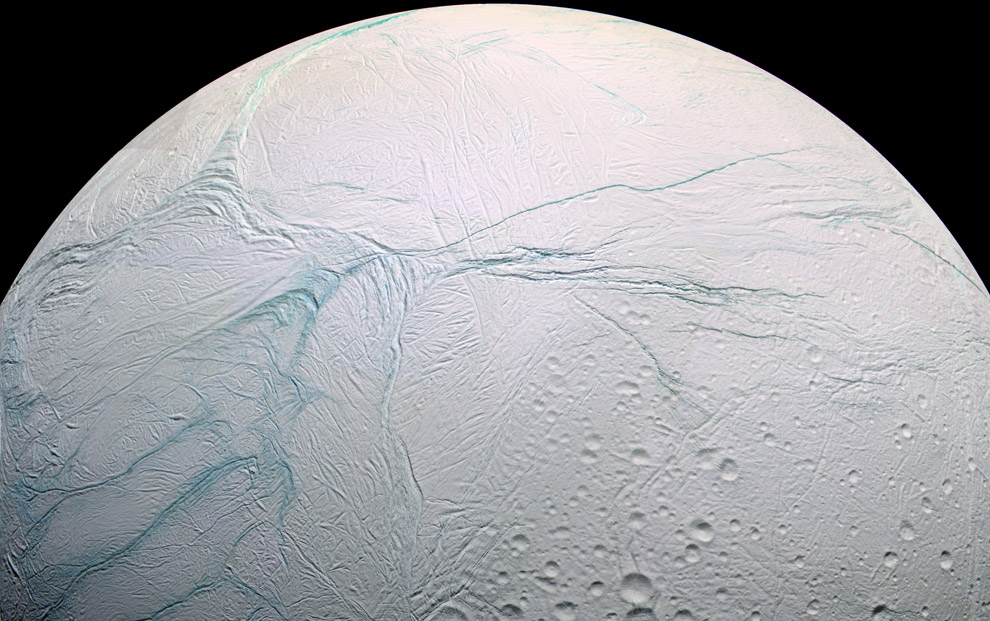
The
tortured surface of Saturn's moon Enceladus and its fascinating ongoing
geologic activity tell the story of the ancient and present struggles
of one tiny world. The enhanced color view of Enceladus seen here is
largely of the southern hemisphere. The south polar terrain is marked
by a striking set of "blue" fractures and encircled by a conspicuous
and continuous chain of folds and ridges. This mosaic was created from
21 false-color frames taken during the Cassini spacecraft's close
approaches to Enceladus on March 9 and July 14, 2005. Images taken
using filters sensitive to ultraviolet, visible and infrared light were
combined to create the individual frames. (NASA/JPL-Caltech) #
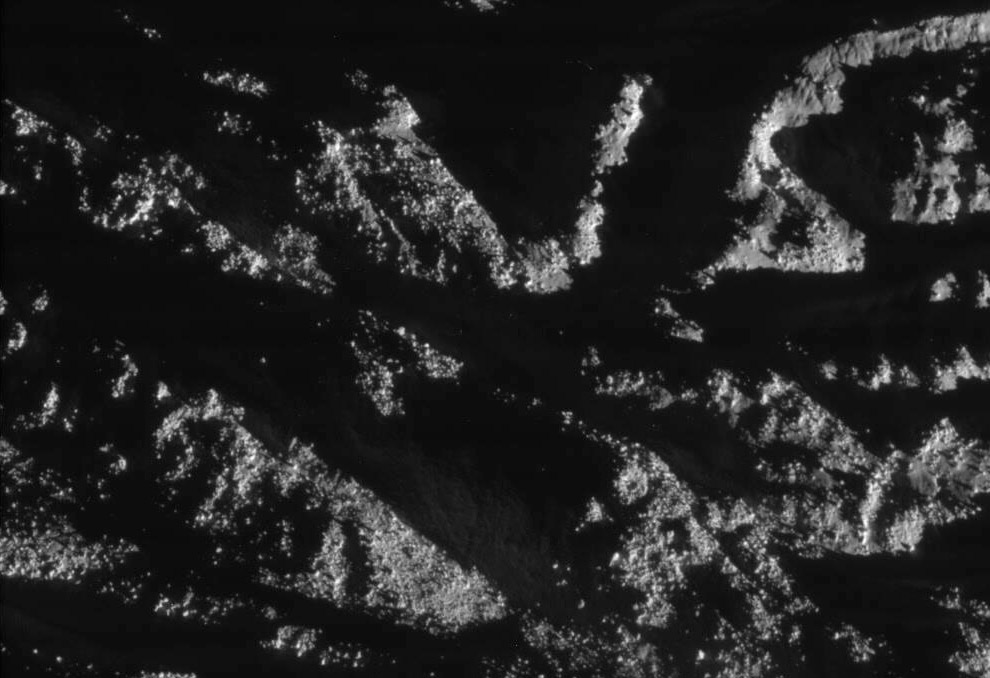
This
image, taken during Cassini's very close flyby of Enceladus on Aug. 11,
2008 captures a region near the Cairo Sulcus on Enceladus' south polar
terrain that is littered with blocks of ice. The image was taken with
the Cassini spacecraft narrow-angle camera from a distance of
approximately 1,288 kilometers (800 miles) above the surface of
Enceladus. Image scale is approximately 10 meters (33 feet) per pixel.
(NASA/JPL-Caltech) #
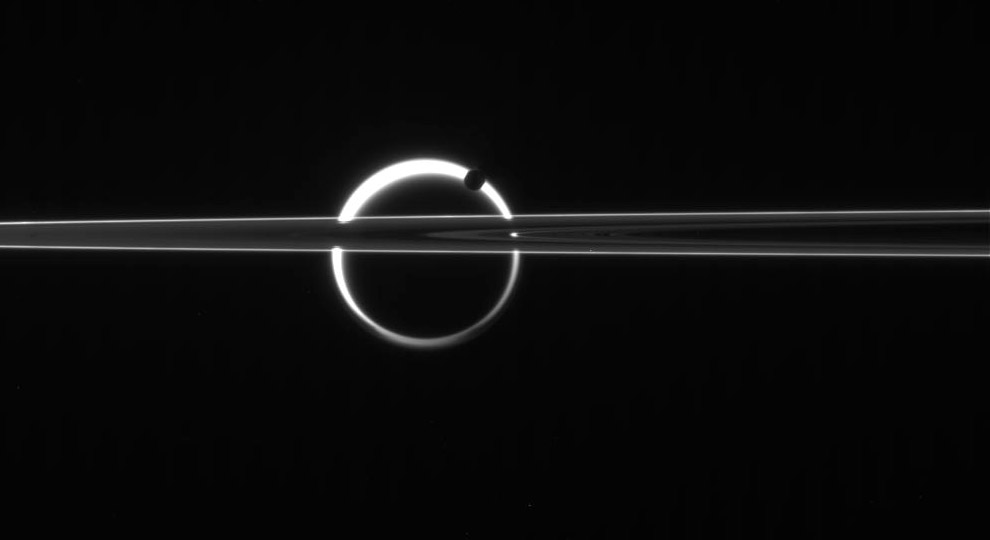
Sister
Moons separated by rings and some distance. Saturn's rings cut across a
scene ruled by Titan's globe-encircling haze, lit up by the distant Sun
and interrupted only by the small, closer moon Enceladus. The scattered
light around planet-sized Titan (5,150 kilometers, or 3,200 miles
across) makes the moon's solid surface visible in silhouette, giant
compared to Enceladus (505 kilometers, or 314 miles across). The image
was taken in visible red light with the Cassini spacecraft narrow-angle
camera on June 10, 2006 at a distance of approximately 3.9 million
kilometers (2.4 million miles) from Enceladus and 5.3 million
kilometers (3.3 million miles) from Titan. (NASA/JPL-Caltech) #
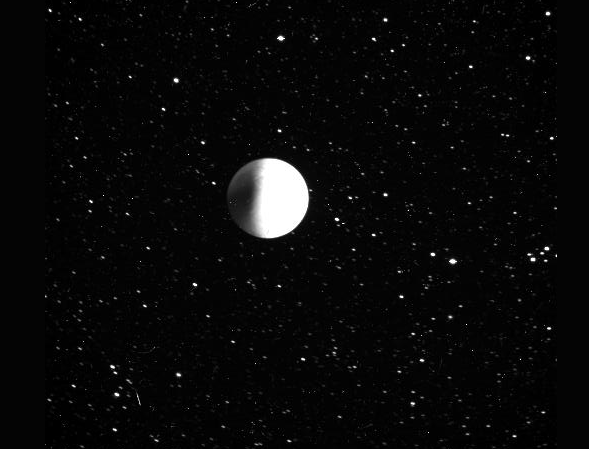
This
sequence of 12 frames was taken over a span of about 45 minutes on
March 12, 2008. In that brief time, Cassini covered almost 40,000
kilometers in its approach to a flyby encounter with Enceladus. The
overexposure and smearing of the images gives a hint of the raw speed
involved - 14.4 km/sec (or 32,211 mph). Shortly after this sequence, at
its closest, Casini approached within 52 km (32.3 miles) of the surface
of Enceladus. (NASA/JPL-Caltech) #
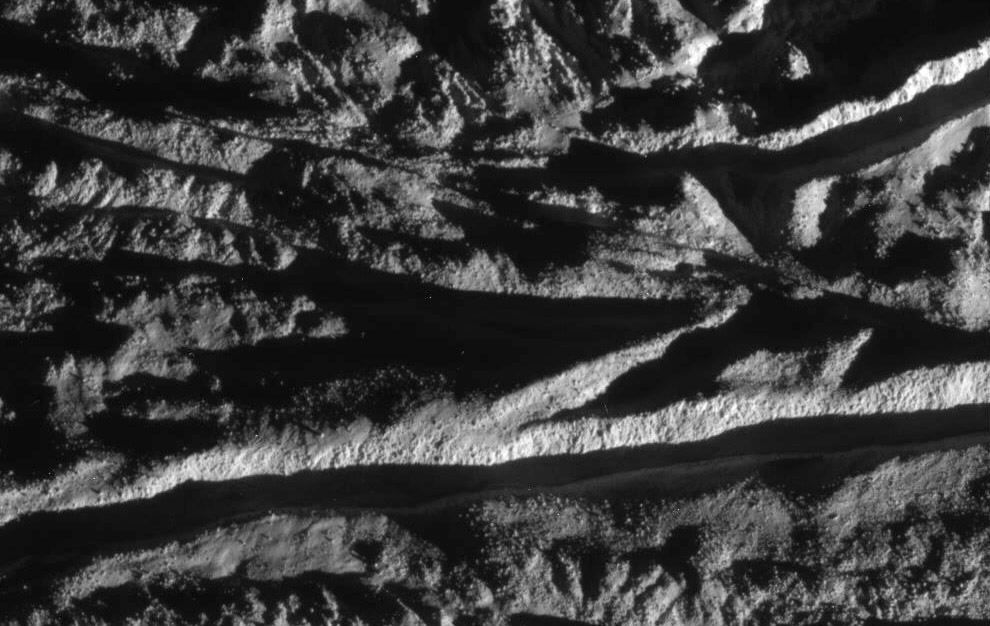
This
image was taken during Cassini's very close flyby of Enceladus on Aug.
11, 2008. Cairo Sulcus is crossing the southern part of the image. The
terrain is littered with blocks of ice. The image was taken with the
Cassini spacecraft narrow-angle camera on Aug. 11, 2008, a distance of
approximately 2,446 kilometers (1,396 miles) above the surface of
Enceladus. Image scale is approximately 18 meters (59 feet) per pixel.
(NASA/JPL-Caltech) #
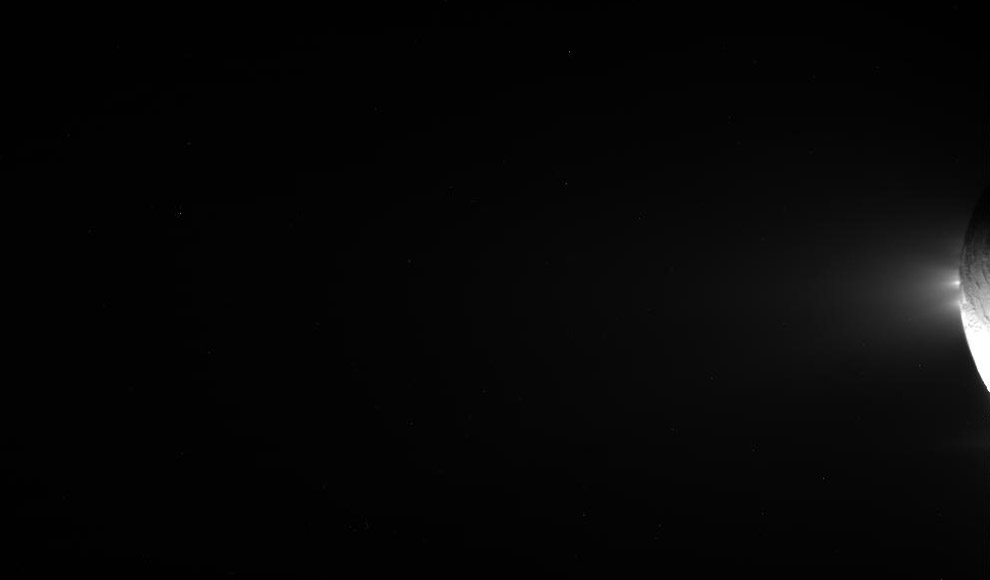
The
active surface jets on Enceladus collectively form a brilliant,
extended plume that is made visible as sunlight scatters among the
microscopic particles of ice. The plume is more easily seen with the
Sun directly, or almost directly, behind Enceladus, as is the case
here. The moon's surface is lit here by reflected light from Saturn.
The image was taken in visible light with the Cassini spacecraft
narrow-angle camera on Sept. 17, 2008. The view was obtained at a
distance of approximately 235,000 kilometers (146,000 miles) from
Enceladus, with a scale of 1 kilometer (0.6 mile) per pixel.
(NASA/JPL-Caltech) #
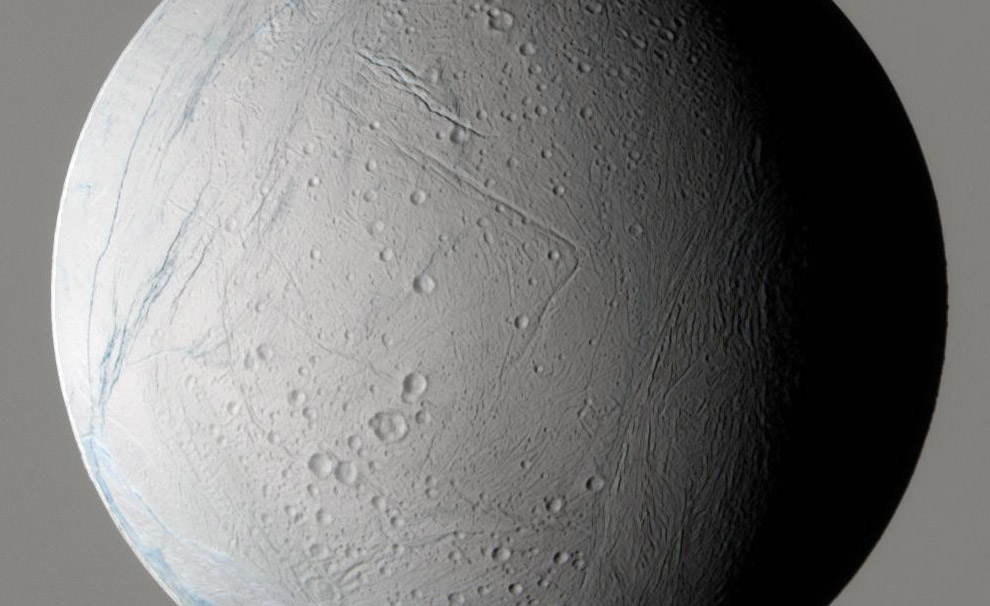
During
its very close flyby on March 9, 2005, the Cassini spacecraft captured
this false-color view of Saturn's moon Enceladus, which shows the wide
variety of this icy moon's geology. Subtle differences in color may
indicate different ice properties, such as grain sizes, that will help
unravel the sequence of geologic events leading to the current strange
landscape. This false-color view is a composite of individual frames
obtained using filters sensitive to green and infrared light. The view
has been processed to accentuate subtle color differences. The
atmosphere of Saturn forms the background of this scene (its color has
been rendered gray to allow the moon to stand out). The Sun illuminates
Enceladus from the left, leaving part of it in shadow and blocking out
part of the view of Saturn. Resolution in the image is about 560 meters
(1,800 feet) per pixel. (NASA/JPL-Caltech) #
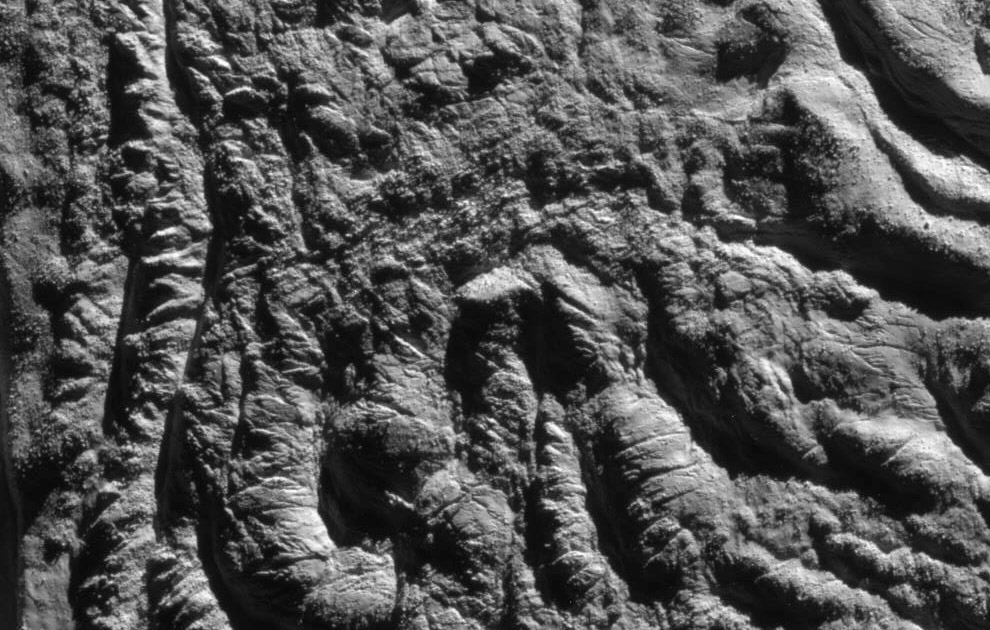
This
image was taken during Cassini's very close flyby of Enceladus on Aug.
11, 2008. Cairo Sulcus is shown crossing the lower left portion of the
image. The image was taken with the Cassini spacecraft narrow-angle
camera on Aug. 11, 2008, a distance of approximately 3,027 kilometers
(1,881 miles) above the surface of Enceladus. Image scale is
approximately 20 meters (66 feet) per pixel. (NASA/JPL-Caltech) #
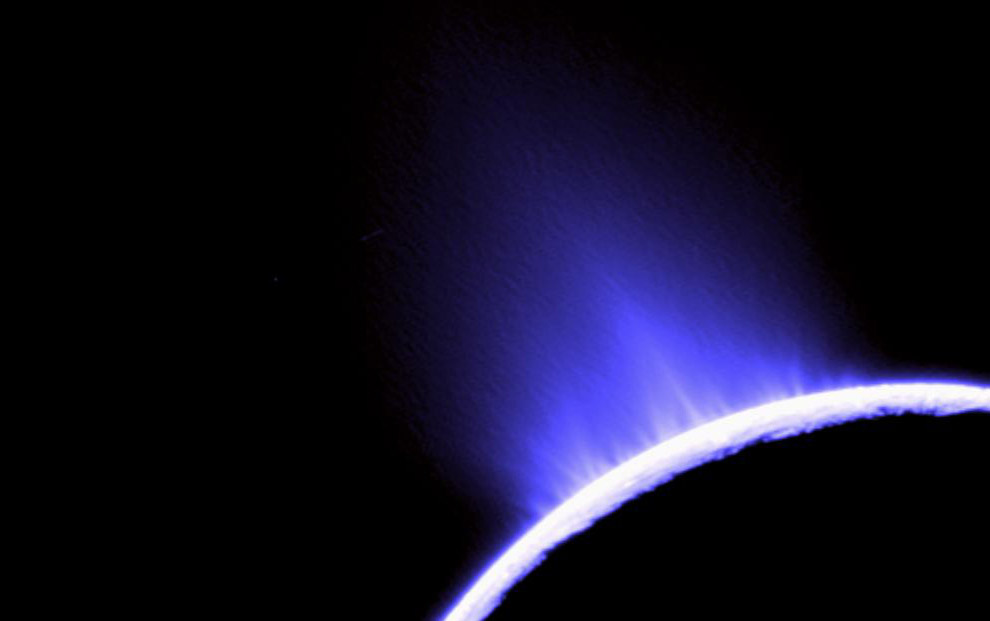
Cassini
imaging scientists used views like this one to help them identify the
source locations for individual jets spurting ice particles, water
vapor and trace organic compounds from the surface of Saturn's moon
Enceladus. Their study identifies eight source locations, all on the
prominent tiger stripe fractures, or sulci, in the moon's south polar
region. This false-color view was created by combining three clear
filter images, then it was specially processed to enhance the
individual jets that compose the plume. Some artifacts due to the
processing are present in the image. The final product was colored as
blue for dramatic effect. The images were acquired with the Cassini
spacecraft narrow-angle camera on Nov. 27, 2005 at a distance of
approximately 148,000 kilometers (92,000 miles) from Enceladus.
(NASA/JPL-Caltech) #
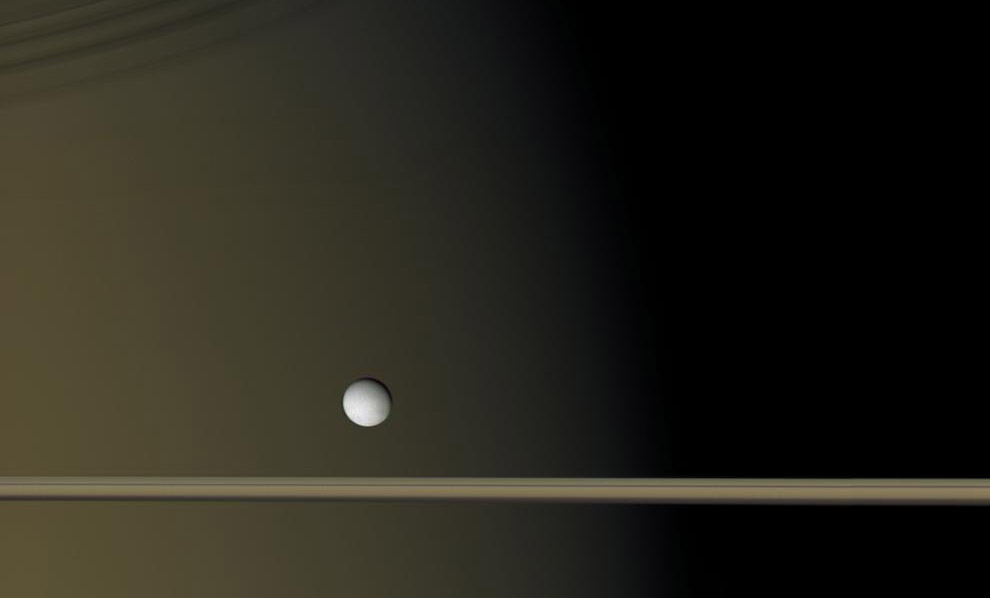
Enceladus
hangs like a single bright pearl against the golden-brown canvas of
Saturn and its icy rings. Visible on Saturn is the region where
daylight gives way to dusk. Above, the rings throw thin shadows onto
the planet. Images taken using red, green and blue spectral filters
were combined to create this natural color view. The images were taken
using the Cassini spacecraft wide-angle camera on Jan. 17, 2006 at a
distance of approximately 200,000 kilometers (100,000 miles) from
Enceladus. The image scale is 10 kilometers (6 miles) per pixel.
(NASA/JPL-Caltech) #
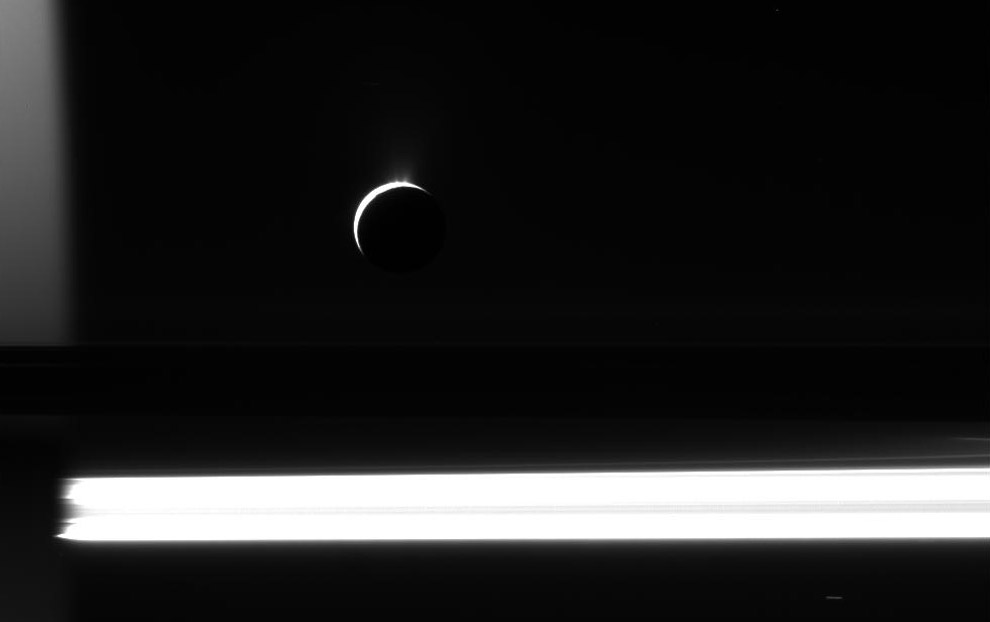
At
least two distinct jets are seen spraying a mist of fine particles from
the south polar region of Enceladus. The particles in the plume scatter
sunlight most effectively at high Sun-Enceladus-spacecraft angles, or
phase angles, making the plumes appear bright. This image shows the
night side of Saturn and the active moon against dark sky. Some
smearing from overexposure is evident. The image was acquired in
polarized green light with the Cassini spacecraft narrow-angle camera
on May 4, 2006 at a distance of approximately 2.1 million kilometers
(1.3 million miles) from Enceladus and 2.3 million kilometers (1.4
million miles) from Saturn. The image was taken at a
Sun-Enceladus-spacecraft, or phase, angle of 159 degrees. Image scale
is 13 kilometers (8 miles) per pixel. (NASA/JPL-Caltech) #
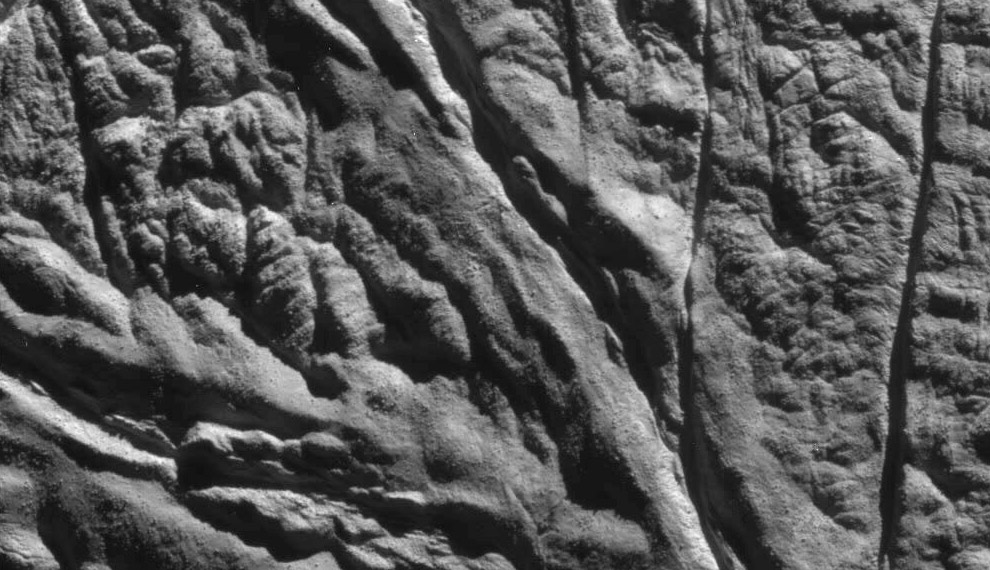
This
image was taken during Cassini's very close flyby of Enceladus on Aug.
11, 2008, taken with the Cassini spacecraft narrow-angle camera on Aug.
11, 2008, a distance of approximately 4,742 kilometers (2,947 miles)
above the surface of Enceladus. Image scale is approximately 30 meters
(98 feet) per pixel. (NASA/JPL-Caltech) #
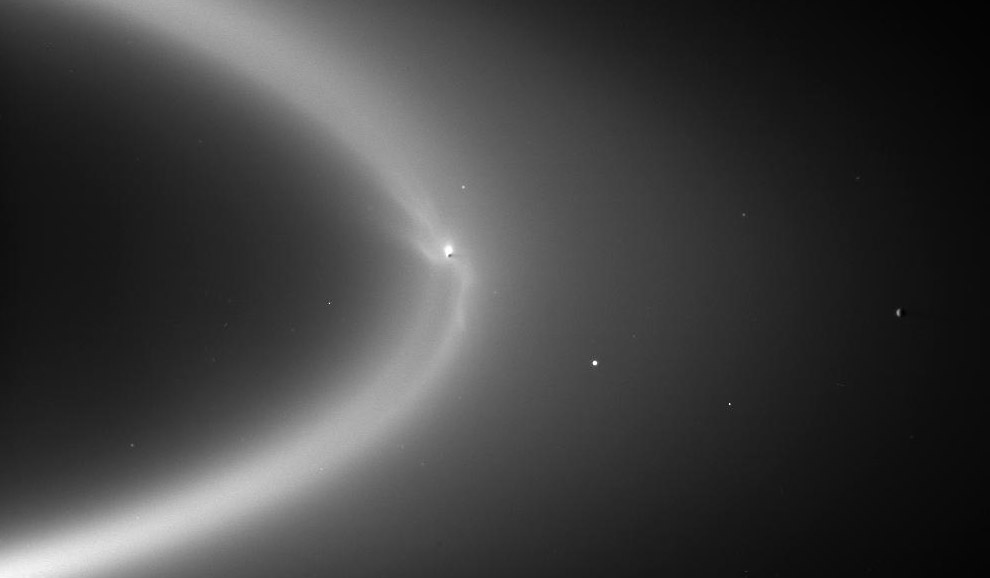
Wispy
fingers of bright, icy material reach tens of thousands of kilometers
outward from Saturn's moon Enceladus into the E ring, while the moon's
active south polar jets continue to fire away. This never-before-seen
structure is made visible with the sun almost directly behind the
Saturn system from Cassini's vantage point. These features are very
likely the result of particles injected into Saturn orbit by the
Enceladus geysers: Those injected in the direction of the moon's
orbital motion end up on larger, slower orbits and trail Enceladus in
its orbit, and those injected into the opposite direction end up
smaller, faster orbits and lead Enceladus. In addition, the
configuration of wisps may hint at an interaction between Saturn's
magnetosphere and the torrent of particles issuing from Enceladus. The
view looks down onto Enceladus (505 kilometers, or 314 miles across)
from about 15 degrees above the ringplane. Tethys (1,071 kilometers, or
665 miles across) is visible to the right of Enceladus. The image was
taken in visible light with the Cassini spacecraft wide-angle camera on
Sept. 15, 2006, at a distance of approximately 2.1 million kilometers
(1.3 million miles) from Enceladus. Image scale is 128 kilometers (80
miles) per pixel. (NASA/JPL-Caltech) #
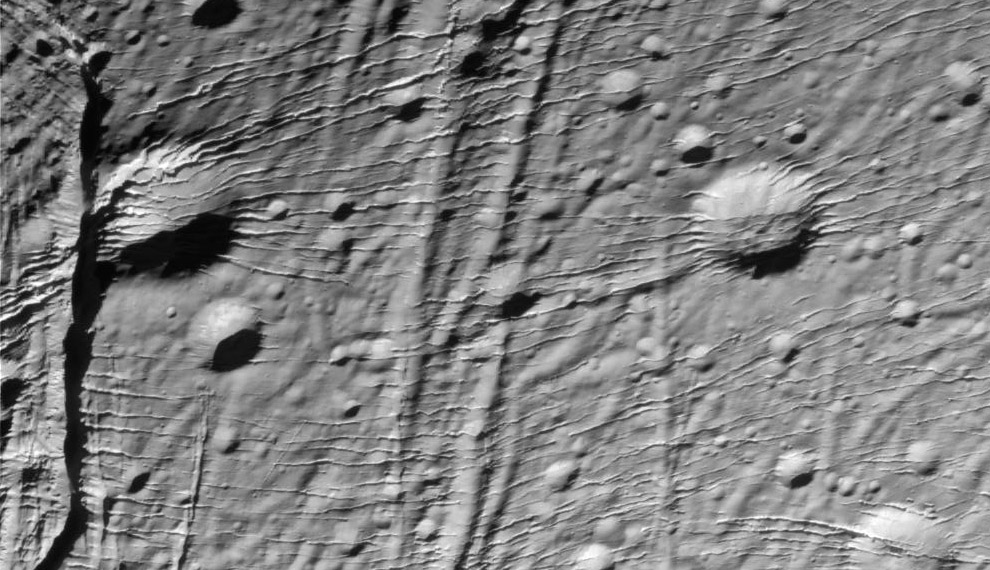
During
its very close flyby of Enceladus on March 9, 2005, Cassini took high
resolution images of the icy moon that are helping scientists interpret
the complex topography of this intriguing little world. This scene is
an icy landscape that has been scored by tectonic forces. Many of the
craters in this terrain have been heavily modified, such as the
10-kilometer-wide (6-mile-wide) crater near the upper right that has
prominent north-south fracturing along its northeastern slope. The
image was taken in visible light with the narrow angle camera from a
distance of about 11,900 kilometers (7,400 miles) from Enceladus. Pixel
scale in the image is 70 meters (230 feet) per pixel.
(NASA/JPL-Caltech) #
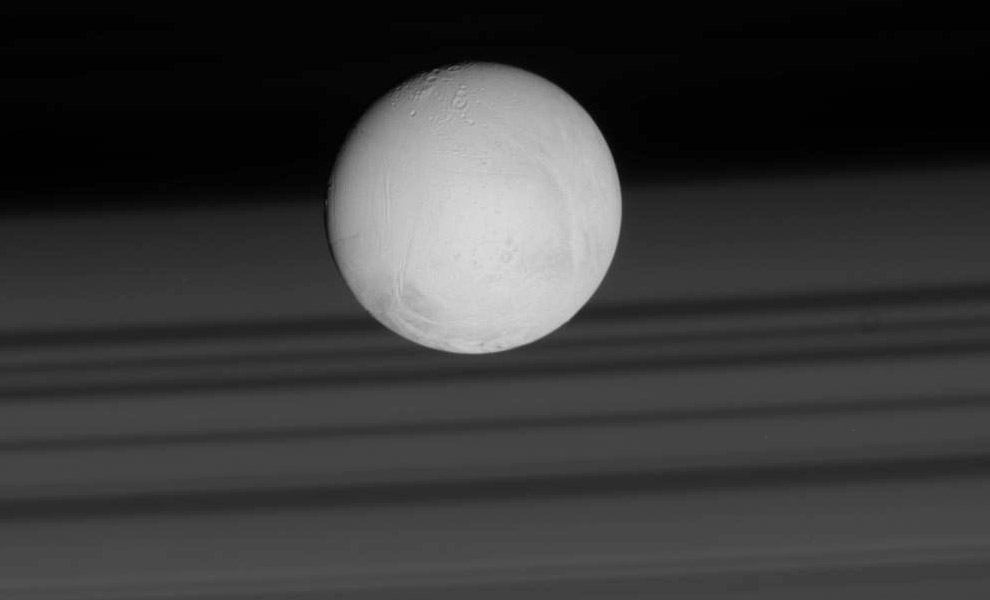
Ring
shadows line the face of distant Saturn, providing a backdrop for
Enceladus. This image looks toward the leading side of Enceladus. North
is up. The image was taken in visible green light with the Cassini
spacecraft narrow-angle camera on June 28, 2007. The view was acquired
at a distance of approximately 281,539 kilometers from Enceladus. Image
scale is 2 kilometers (1 mile) per pixel. (NASA/JPL-Caltech) #
More links and information
Cassini-Huygens - Main NASA site
Enceladus - Details on Cassini site
Enceladus - Wikipedia Entry
This blogger might want to review your comment before posting it.


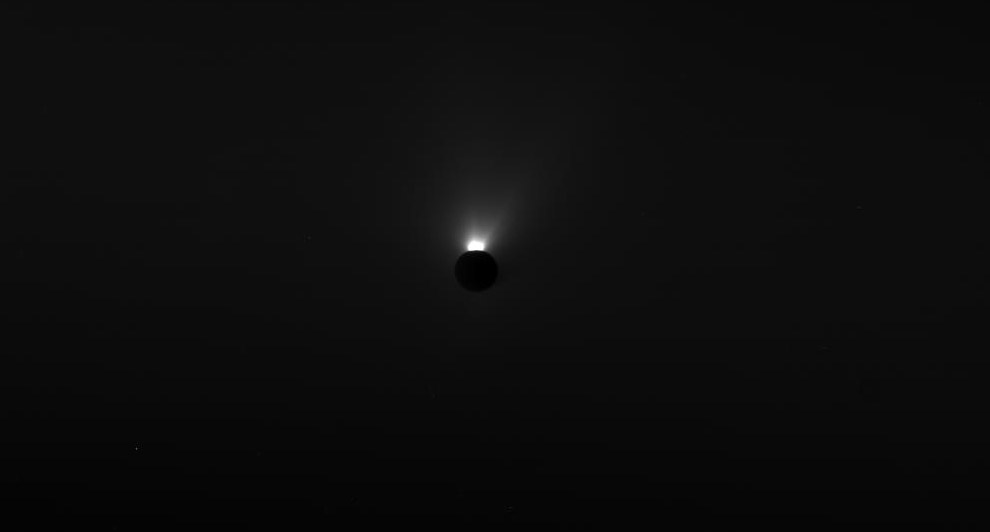
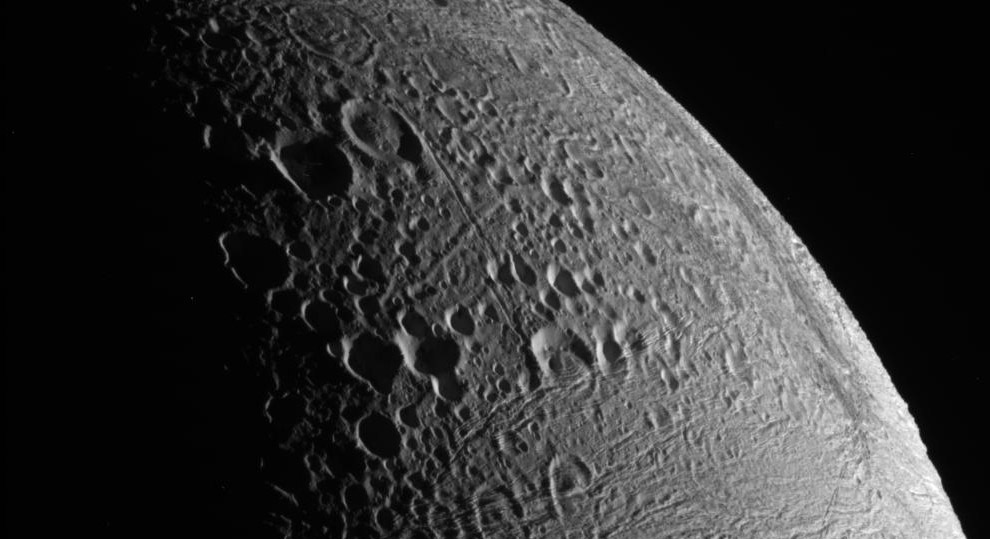
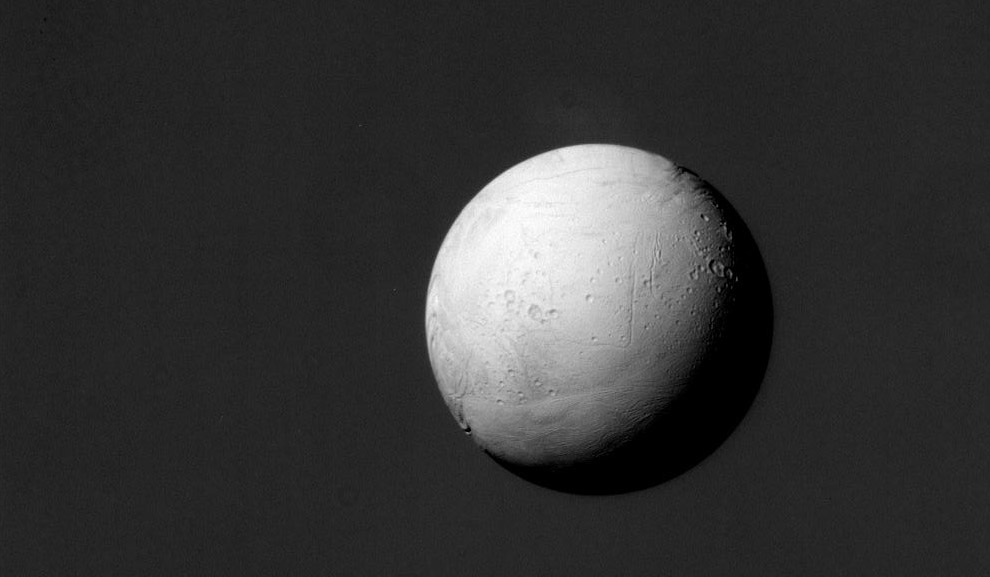
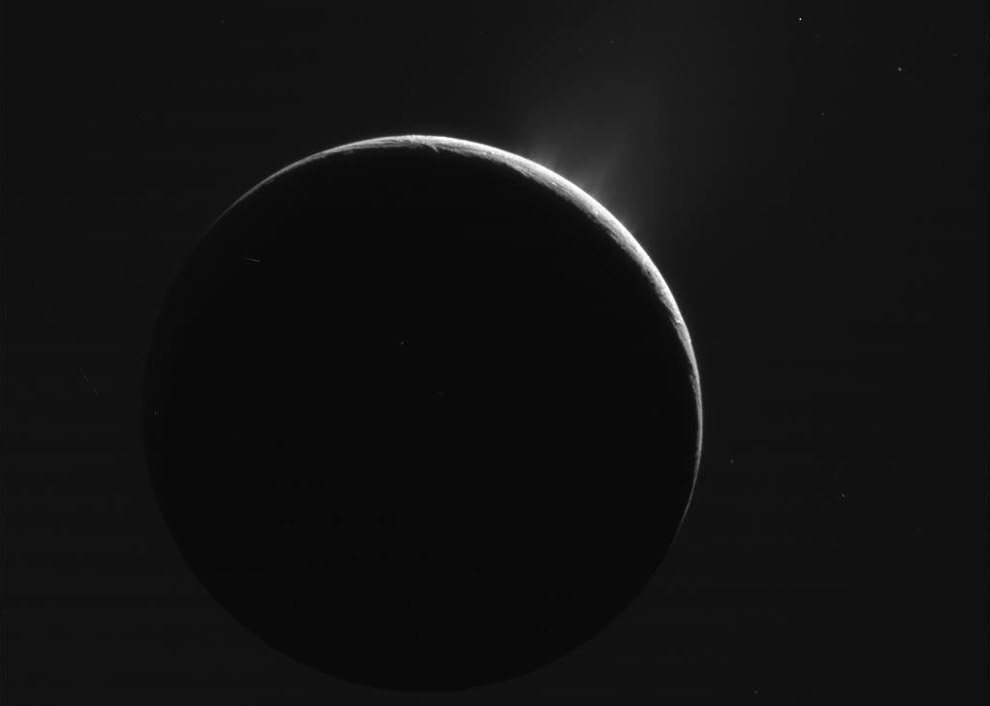
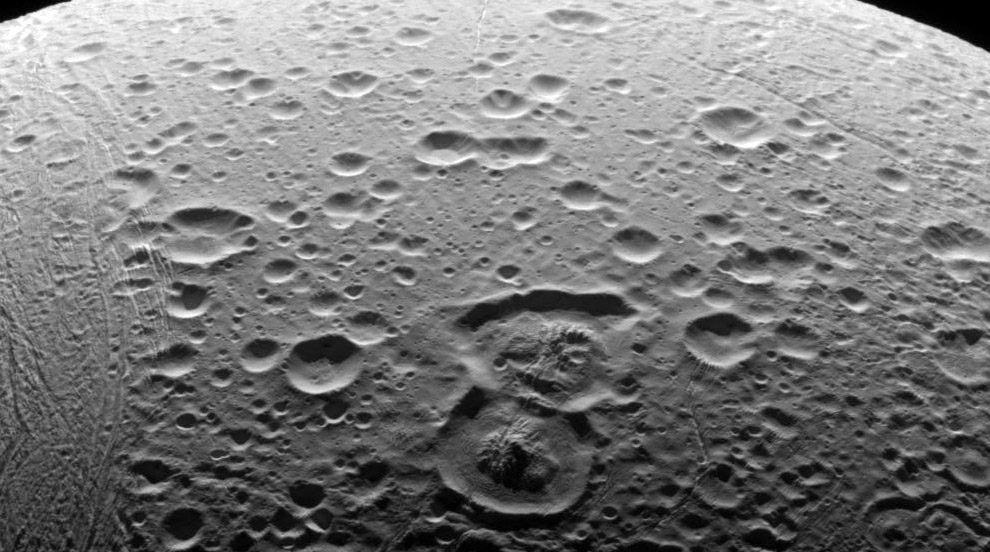
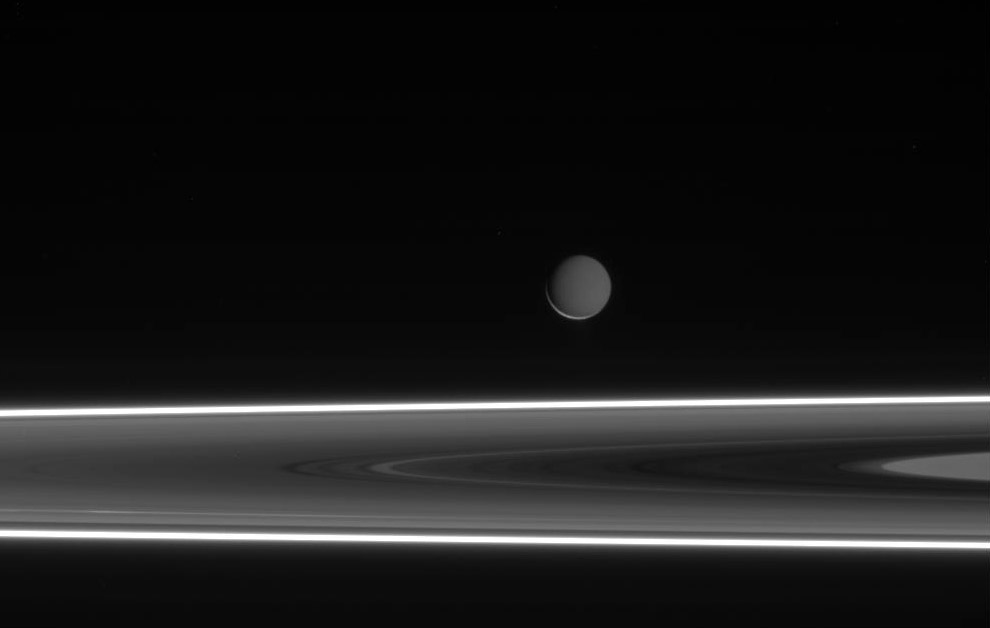
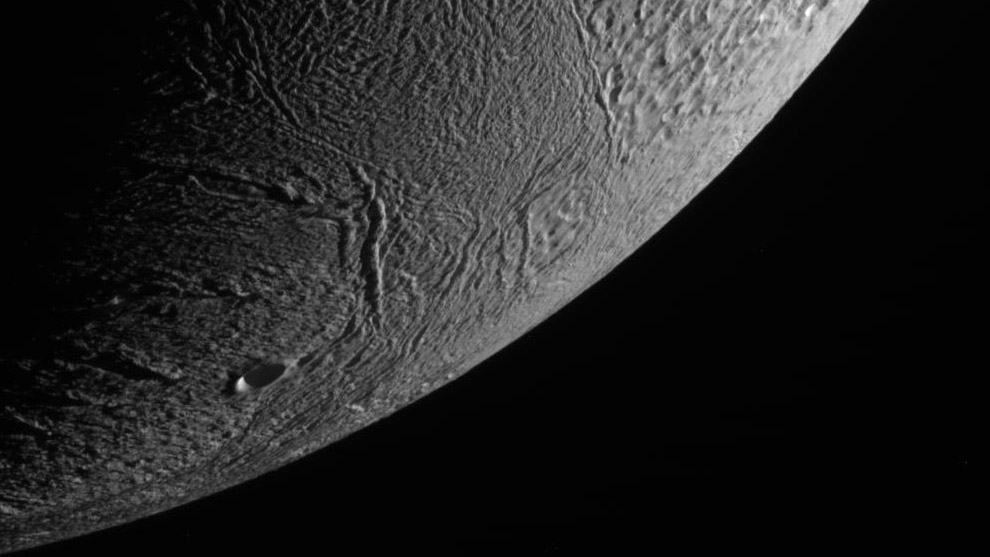
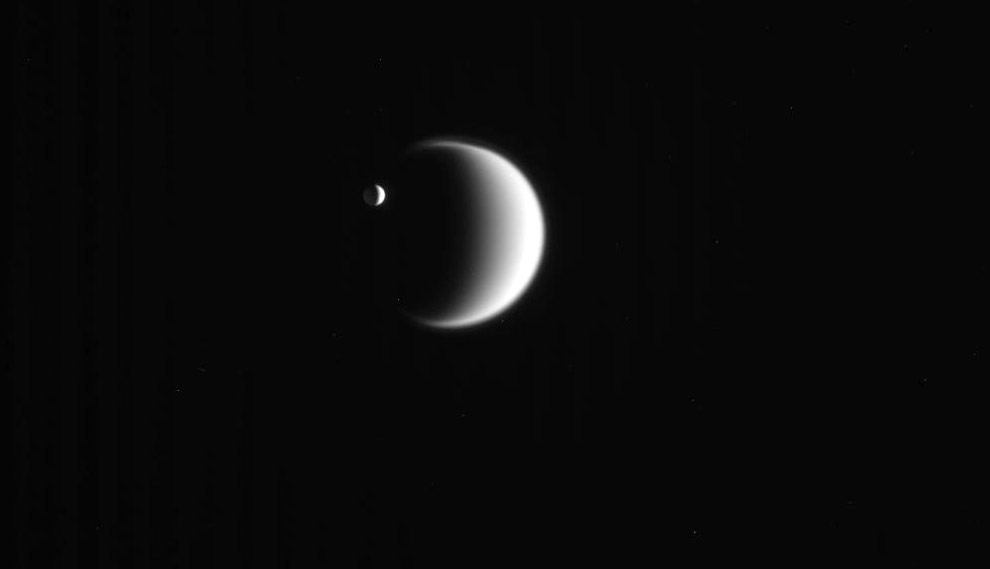
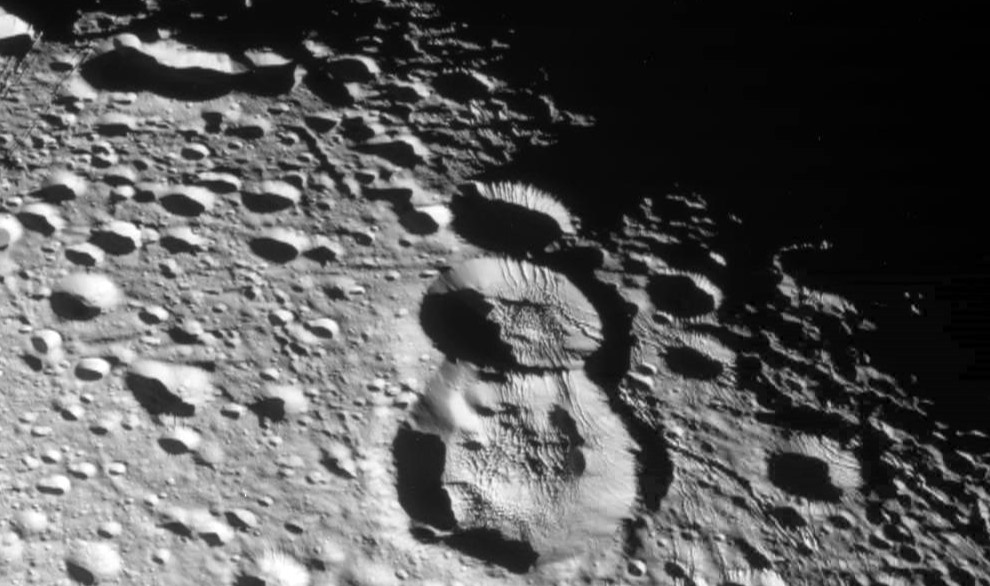
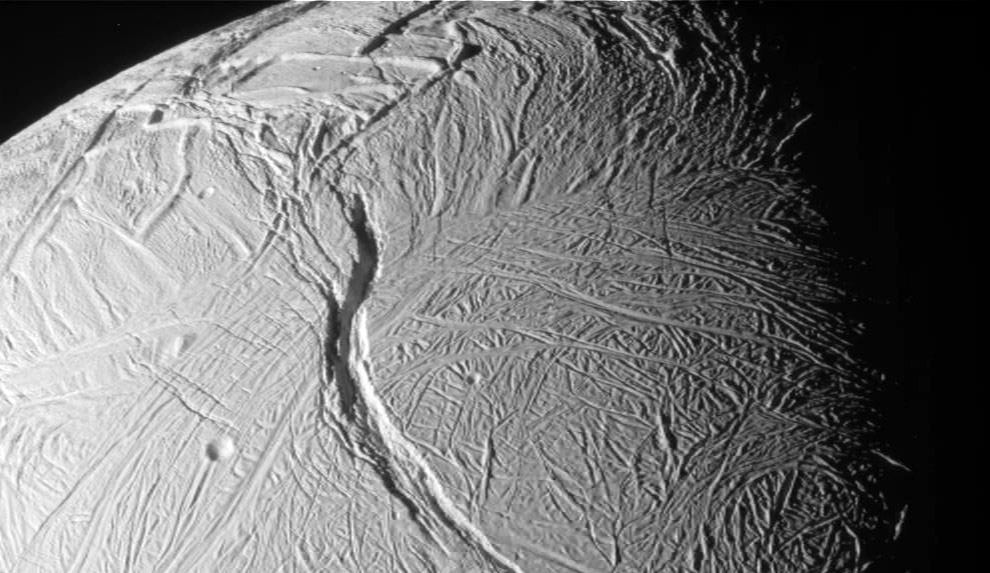
Awesome. What is the resolution of the digicam they used?
Marnail (#63) I get tired of seeing uninformed comments like yours. The entire 50-year history of America's space program has cost us $810.459 billion. The last 7 years of Iraqi and Afghanistan warfare have cost us $604 billion. If you want to rail against something that costs a lot but gives nothing in return, you should protest the Iraq war.
NASA's budget is approximately 0.4% of the current federal budget. In return, it has given all of humanity innumerable technological spinoffs that are worth countless trillions of dollars and have enhanced all our lives.
What amazing photographs. Thanks for the footage NASA! It looks like something out of Kubrick's 2001 A Space Odyssey.
What is the surface temperature of this tiny moon of Saturn?
These images are incredible. Thanks so very much.
Thank you, Cassini and all your planners, builders and enablers. Enceladus is now my favorite Saturnian moon.
What amazes me is we can build robots that dance circles around the rings and moons of Saturn, but the same Government can't build a refugee trailer in New Orleans without screwing it up at twice the cost.
MARNAIL, if you look at how much money is spent on space exploration these days, that amount of money won't help solve those problems on earth. Besides, scientific research has many spinoffs that actually help the economy and make money for the USA. Things like poverty, hunger and war have existed for as long as people have been around. No amount of money will wipe it out. It's human nature and corrupted governments that are causing those problems. Stopping all space programs will not do a single thing to help solve these problems. The world isn't as simplistic as you seem to think.
With that said, these pictures are amazing! Very beautiful.
woooow..... amazing...... mind blowing!!!
All I can say is....OMG!!!
The scientific information is very helpful to us Americans especially the children of today. To continue to cram politics down there throats is very unessential to their knowledge. People like #63 can complain about the government, but education in science is very important to our children. The other countries are far more advanced in these teachings. So if you have children share some scientific insight along with your nagging complaints of the problems that we have more or less brought upon ourselves as separate thinking citizens. Our first priority in getting this USA back is to think togetherness as Americans.
Virtually these images are so comprehensive! AMAZING! Viewing these images is highly educative of space and lighten up the Human Brains!
Marnail...
Once again I will point out that the NASA space program is not a waste of money.
The entire NASA budget for 2009 will be $17.6 billion. Compare this to the military budget of $515.4 billion, this does not include Iraq and Afganistan, with $143 billion going solely to R&D, nearly 10 times the NASA budget.
Pres. Bush asked for a $3.1 TRILLION budget for 2009.
NASA's $17.6 billion is anlo .06% of the total budget. Do a little looking befor posting such stupid comments.
As I understand it, for the the spacecraft to get a sharp picture it must pivot around its axis at precisely the right speed to compensate for its forward velocity as it passes the subject. This is something we do instinctively to take a shot of, say, a passing race car. The calculations, timing and precise control of the spacecraft to perform this ballet is amazing to me.
Awosome!
The most amazing fact is that we are just beginning to get to know our solar system which is such an insignificant portion of the vast reaches of the universe. We have so much more to learn and seemingly so little time to do it in. Isn't it grand to be in this time in space?
Truly amazing images. Excellent job, NASA!
It's interesting that one of the viewers here was wondering, suspiciously, why there were no stars visable in the pictures, reviving the rumours that these pictures were faked as were the men on the moon pictures. The answer is, of course, that the difference in light intensity makes the stars so dark they are just not visible. The light of both moons, ours and theirs, washes them out. Trust me. There is no Santa Claus and there is no outer space conspiracy. Great pictures.
If anyone was looking for a reason for any govt. to spend money on space exploration...
Absolutely brilliant photo's. Contrary to Marnail's opinion (#63) space explorations is not a waste of money as he says. The technological spinoffs far outweigh the cost of space exploration and may solve some of the world's problems.
Dear Marnail:
You're right, all that money spent on space projects has been a total waste.
Please throw away your cell phone, your blackberry, your microwave oven, anything you own that uses velcro, your freon-free refrigerator, your iPod, and your laptop computer with wireless connection. Immediately.
Have fun hunting rabbits and cooking them on a stick over an open fire.
Terrific!! Go NASA!
SanDiegoMark,
How is Marnail going to start his fire and sharpen his stick?
Home!
Well, it is difficult to express the overwhelming feelings this inspires.
I have no doubt whatsoever that there is a higher power in charge
of all creation. This just reaffirms my humble gratitude for all living
things...from the miscroscopic (in all things) to the vast, magestic
regions of eternity...one continuous round of beauty and life. I am
awed by every beautiful picture that I see. Sure does make me
slow down...sit back...and alter my priorities and perspective. It
seems there are many things in life that do this. It is happening,
yet again. Love it! I, too, say "Thankyou" for the trip.
arghhh....
Nasa:
1. Provides jobs for nerds that would instead be addicted to WOW.
2. Gives us pictures. Thats right: PICTURES! I have yet to benefit from a picture, I'd rather have lower taxes, even if its $1.00 less (that's a coke!)
3. It's a relic of the cold-war space race. What do we need to prove anymore?
4. It's funded on the hope that we'll be living a Star Trek life one day! Sorry, but the laws of physics will keep you from ever leaving our little green planet.
5. Maybe we could colonize mars? Nope, NASA won't even colonize the moon! They'd rather let dude's muscles waste away in the ISS.
6. But we have velcro! What did we ever do without VELCRO?
Sure... we waste a lot of taxpayer money on a lot of stuff: wars, election campaigns, and supporting large numbers of "Welfare" drug habits. But that doesn't mean we should be looking to waste more money on a defunct space program.
Wow, it's so beautiful... This is like space porn. Did I see the Rebel Alliance's sheild generator in that close up?
I'm always disgusted by the anti-technology idiots spouting off about "wasting" money on the space program. For a SHORT list of things that have improved all our lives, directly attributable to the space program...
http://en.wikipedia.org/wiki/NASA_Spinoff
Again, that's a VERY short list. Things like CAT scan, angiograms, medical telemetry, the entire solar energy industry, weather prediction and storm tracking, and endless other technologies that DIRECTLY IMPROVE YOUR LIFE!
Here's a longer list, but some may question the source.
http://www.thespaceplace.com/nasa/spinoffs.html
The space program is the ONLY government program that EVER paid for itself.
i'd echo some of the statements made earlier that its eerie yet awesome. However some of the photos looked very computerized. So i'm just curious as how scientists construct certain images, and how others look much more realistic.
It's quite incredibled and amazing! Really!
Thanks from the NASA !
Mindblowing.
beautiful. took my breath away.
What a honor to see these pictures! I am so glad I have lived long enough to see them. Thank you NASA!
Thats no moon...it's a space station!
I CONGRATULATE all involved in providing these photographs.
Scale in pixels, is fine for resolution, but a scale would be interesting.
This opens a new moon to my imagination.
21 is so unreal..... spectacular.
Totally sweet
The opportunity to view these images, with the underlying knowledge that so many individuals on many (sub) teams created them, is truly heartwarming and deeply touching. Imagine ions from now, when the sun is much larger, and life abounding on Enceladus, we can say now, in this time and place, that we have succeeded.
steve asks "Where's the monolith?", referencing the book "2001". Well, it must be on Iapetus. ;-) (Or "Japetus" as Clarke spelled it.)
observer asks why there are no stars in any of the pictures -- well, there *are* stars in a lot of the pictures; all the ones where there's a long enough exposure to capture their faint light. At least one frame of the animation in #9 shows star trails (revealing just how quickly Cassini is slewing to keep Enceladus in frame). There are stars in some other images too, but beware: many of these pictures are raw images, and have not been treated to remove stray cosmic ray hits on the CCDs. Some "stars" aren't really stars.
@92:
You are a moron. The Nasa program is probably in the top 10 of human endevours. You also need to understand the laws of physics you quote. At our level of technology we can not, but some day we will.
@ 28. take a photography 101 class
Fantastic photos. I could spend hours studying them. The clarity is astounding to be from such a distance.
Absolutamente maravilloso. Me siento encelado por Encelado. Gracias!!!
Incredible, truly incredible what technology has allowed us to see.
Thanks NASA
I remember objections here in Florida to the Cassini launch. I suppose 63 was one of them. Thank you NASA, thank you America, for sharing this with the world!
space is amazing!
MARNAIL, you short sighted, narrow minded fool. Whilst it may be difficult for you to see the relevence of this and other investments in space science, the information it provides is of the highest importance to the long term future and continuation of the human race. At some point Earth WILL be hit by an object which will instigate a planetary change, and at this time, at the end of habitable life on this planet, we had better have found a way to inhabit somewhere elce. These are the baby steps the human race needs to take in order to make this possible, and secure the future of the species. Whilst things could be made better, here, now, what is the point of making them so, when the outcome is inevitable oblivion. It may be a very long time off, but does that make it any less important, or should we just hope someone elce will do it? Think of the present if you must, but with it you sacrifice the future.
Amazing!!!! Beautiful, and interlectual!!
Breathtaking ... it brings on the stark realization that we are a fortunate lot to exist in such a way that enables us to see what we are a part of. Makes me wonder if we are part of a plan or a serendipitous element in the ever-evolving Universal chaos of Natural Deletion (and if we're alone in that quest). Science rules ... thank you.
amazing what mann can do
#92: " 4. It's funded on the hope that we'll be living a Star Trek life one day! Sorry, but the laws of physics will keep you from ever leaving our little green planet."
Might I direct your attention here?
http://www.challenger.org/hab/
Yeha..just a big stone. And by showing these amazing stone pics those poor scientist try to make us believe that have done something important and need more money to get even better pictures...maybe next sad american house loans could be used for this..
all these pics are very pretty but I need one of SATURN not the moon but I enjoied looking at them and reading about them
#92:
"1. Provides jobs for nerds that would instead be addicted to WOW."
No. The value of jobs created through NASA programs is not in entertaining geeks but in increasing American aerospace engineering expertise. Time was, if anybody wanted to launch a commercial satellite, they had to pay an American company (eg. Boeing, Lockheed) to do it. But as we have rested on our laurels, trusting that we have the technological lead in aerospace, other countries have not been so complacent. Ariane, RSC Energia, and RSC Khrunichev are big players, and they will outcompete us if we're not careful.
I am not afraid of other countries putting men on the moon or anything like that. The more the merrier, I say! So we don't need a space race. But at the same time, can we really afford to let other countries pass us up technologically? India, a growing player in the aerospace industry, has just launched a lunar orbiter, Chandrayaan 1. I think that's wonderful. But it means we have competition in the industrial sector. I for one do not want to see more high-tech jobs leaving this country because folks didn't want to invest in them and preferred to stay at our 1990 technology levels.
"2. Gives us pictures. Thats right: PICTURES! I have yet to benefit from a picture, I'd rather have lower taxes, even if its $1.00 less (that's a coke!)"
Cassini is returning so much more than pictures. The pictures are awesomely majestic, but the real benefit is in the scientific data. You'd be surprised what you can learn from studying the universe. And it's information that could save us as a species in a few centuries, when the time comes to colonize other worlds.
"3. It's a relic of the cold-war space race. What do we need to prove anymore?"
Nothing, at least on the political level, in my opinion. But science is valuable for its own sake, and the technology developed through a space program is extraordinarily valuble in terms of advancing the state of the art. Forget velcro. The real payoff comes in the engineering know-how that accumulates in the aerospace industry. Do you know just how much engineering goes into a commercial commsat? How about airport runway safety systems? Turbofan blades? De-icing systems? America is losing the lead in many of these areas. Thanks to a concerted effort to push our capabilities on the part of NASA, we still enjoy a considerable lead in space engineering, which is far more important than a lot of people realize. But the lead is shrinking. American companies are starting to outsource launch services. How long before they start buying satellite busses and spacecraft computers abroad as well? Do we really want to see more jobs going overseas?
It takes government investment to build a really strong aerospace industry. In most countries, the lion's share of this funding comes from the military. America is unique for having such a large *civilian* investment in the industry, in the form of NASA. Let's not throw that away.
"4. It's funded on the hope that we'll be living a Star Trek life one day! Sorry, but the laws of physics will keep you from ever leaving our little green planet."
What makes you so sure? The laws of physics don't prevent leaving Earth. They merely tell us how much effort is required to acheive it. Someday, we will have to leave Earth, or face the reality of massive overpopulation.
Oh, and Earth is mostly blue, not green.
"5. Maybe we could colonize mars? Nope, NASA won't even colonize the moon! They'd rather let dude's muscles waste away in the ISS."
So.....spaceflight is pointless and it's not possible to leave Earth, but you'd rather NASA colonize Mars than keep the ISS going? The ISS is valuable; a lot of research happens there, but most significantly, it is building the industrial infrastructure neccesary for lunar and, eventually, Martian colonization. You can't just say "I'm gonna buy me a Mars ship!" and do it. There's no company that builds them. So if you want to colonize Mars, your first step has to be to build an industry that can build Mars ships. The ISS has definitely increased the engineering capacity and the state of the art for human spaceflight in the US. In my opinion, that is the most important contribution it makes.
It *also* enables serious and very important research on the effects of long-duration spaceflight. Now, the Russians established years ago just how significant muscle wasting is, but they still haven't perfected means of coping with it. Right now, we don't know how to keep astronauts in sufficiently good condition that they'd be fit for Martian exploration after a six-month cruise. We're getting a lot closer, but it's really a tough nut to crack. As a side benefit, the research is also benefiting people on Earth with degenerative disorders or who are bedridden. The osteoporosis drug Boniva came out of NASA-sponsored research to try to find a drug that would counteract the bone wasting that occurs in space.
And that's not all that's happening up there, either. They're doing other scientific work too. The newly arrived ISS crew will soon be receiving a water recycling system (to be delivered by Endeavour in a few weeks). Right now, the ISS relies on regular resupply, and water is one of the big consumables. (They use it for oxygen generation, drinking water, food preparation, and cleaning.) This is one of the major stumbling blocks facing any Mars exploration. It needs to be solved before we can go to Mars, and cancelling all manned space exploration will definitely not help.
Other experiments range from crystal growth (which isn't just about aesthetics; protein crystals grown in space exhibit different properties which is extremely valuable for medical research), cell cultures (turns out, tumor cells cultured on orbit grow more like ones inside the body than ones grown in a petri dish on Earth, which is hugely valuable for cancer research), plant growth (again, vitally important if you ever want to go to Mars), embryology, fluid dynamics (which has applications practically everywhere), and so on. There are more applications to space research than most people realize, but you have to get into some seriously dry reading to find out about it, because the scientists in charge of these experiments aren't generally big on blowing their own horns.
"6. But we have velcro! What did we ever do without VELCRO?"
Again, Velcro is the least of it. If you can't see past Velcro, then you really don't understand what the space program is good for.
#119 You can look at Saturn images to your heart's content here: http://ciclops.org/index.php?js=1
Now, think about this: you have an object the size of a bus moving at 14.4 km/sec that you have to reposition throughout its flight to point different instruments at whatever you're observing. Oh yeah, and you manage to come within less than 52 km of Enceladus AND fly through a plume of ice particles (which BTW you've done more than once already). One more thing -- you pass by TItan from time to time to change your orbit so you don't waste fuel. Wow!
@Jaymie (#51)
It may take some DIY legwork, but according to NASA/JPL, you're allowed to use the original images pretty much however you wish:
http://www.jpl.nasa.gov/imagepolicy.cfm
"JPL Image Use Policy - Unless otherwise noted, images and video on JPL public web sites (public sites ending with a jpl.nasa.gov address) may be used for any purpose without prior permission, subject to the special cases noted below. Publishers who wish to have authorization may print this page and retain it for their records; JPL does not issue image permissions on an image by image basis."
So you should be able to dig up the full-res image(s) you want from the NASA/JPL site:
http://saturn.jpl.nasa.gov/multimedia/images/index.cfm
and have it/them printed whereever you'd like.
Kiitos teille kaikille,jotka edesautoitte näiden kuvien saamiseksi.
Vau todella hienoja kuvia, ihastuin itse eniten siihen kuvaan jossa oli sinistä väriä mukana.
Todella upeita, näitä on ilo katsella
Absolutely stunning and eerily fascinating pictures of Enceladus. Obviously, a very interesting body with much to engender future study by our friends at JPL. Perhaps they could now concentrate on a LEO satellite that could observe Ms. A. Waldman on her cupcake foraging expeditions. Make mine with extra sprinkles and a Swedish Fish or two. I need the Omega 3 oils from those cold leetle fishies.
According to the U.S. Constitution, one of the Vice-President's duties is to serve as Chairman of the Board of NASA.
Can you imagine Sarah Palin as Chairman of the Board of NASA?
She'd better start brushing up on her rocket science. : )
Muito show, legal pra caralho!
Well done Calli Arcale for an excellent post. Well informed and well argued unlike a lot posts on this subject.
Humanity must also advance in parallel with attempts to solve the world's problems. We can't fix one at a time.
One day a situation will present itself where leaving the planet is the only option and people will be looking to NASA for the answers. Potential incidents include global warming, over population, radiation from the sun, etc. Anyone seen Wall-E?
The fact is that humanity must progress. We currently have all our eggs in one basket and that's not good for humanity. Photographs like this only confirm to me the power of humanity and what it can achieve, yet out efforts are very much still in their infancy. It's inevitable that one day we will leave this planet and inhabit new planets and moons. The fantastic work being done by NASA is merely our first steps. There's water on Enceladus, isn't that worth checking out?
My only disappointment is that not enough money is being invested contrasted to other expenditures. It was 1969, 50 years ago, that NASA captured the imagination of the world. Truly uniting humanity as one organism. Urging success for Armstrong, Aldrin and Jackson in their quest for all of us. It united the world and for a brief moment, everything was alright and good in the world. I can't help feel that we need another one of those to get a bit or perspective. Today's political and financial climate looks like that might now happen but the danger is that we'll descend into a downward spiral and never come out if spending is cut. I'd like to hear comment on that subject.
It seems a little late in the day to not be on Mars yet. I have watched the documentaries on the huge challenges that lie ahead for such a project, but 50 years in todays technological acceleration seems slow. Anyone that is a naysayer to Space exploration is very shortsighted and if the world was run by those people we'd still be on horseback. Humanity has a long way to go yet and NASA are one of the good guys who can help take us there.
What did Velcro ever do for us? It's like glue without the stickiness. Come on, that's easy.
C
#121 (Followup) If you'd like to take a virtual ride with Cassini during one of its encounters, check out the CASSIE software. It can be found here:
http://saturn.jpl.nasa.gov/multimedia/CASSIE/
Calli has some very relevent points, the world or even for that matter the universe is evolving and the natural resources of the Earth cannot be sustained at this rate so of course we are going to need organisations like NASA to investigate the universe.
What is Millions if not Billions of dollars compared to the slow demise of the human race without anywhere to go to? If NASA wasn't investigating the universe then we would no idea if we could leave this ever dying planet.
So of course NASA needs funding, i mean it will surely one day save the human race from demise... Unless you want that to happen...
#126, I want some of whatever you smoked, drank, or ate in order to find that in the US Constitution.
Thanks very much for the pictures. You've made a wonderful selection.
However, some of us would like to obtain the originals (if available) for our own use because the originals are often available in higher resolution. Could you please provide picture IDs or some other information that we could use to find the images on NASA's site (or whatever organization produced them)?
Thanks again for the pictures.
Merci d'offrir à tous ces fabuleux spectacles.
J'aime l'idée que cette mission rend hommage à un compatriote
thanks
When we stop looking up, we stop growing.
These pictures are awesome. Thank god there are people on this planet disciplined enough to want to discover what is around us. Sooner or later, they will discover that we cannot be alone in the vastness we call space.
Umm... Buzz? ... (Comment #97) I can see that you have no use for anything involving space... but if all of your eggs are in our one little Earth basket, perhaps you should learn a little about it. The planet, the one YOU live on, is referred to as "The Blue Planet," not green. Because... well,,, because of all of the WATER here. W-A-T-E-R... B-L-U-E... get it? Perhaps you were thinking of space as in "little green men from Mars" or something. Still... that's not Earth.
Add #92
I don't see the point why should we argue about usefulness of bringing something new (knowledge, discovery, invention) to the existence to somebody who cares more about his coke. If he thinks that it is better to eat good meals, drink good drinks and raise children same ignorant as we are, it is his right. We should give him his coke if he is good citizen and let him to push the wheels of the world so that people who have the visions can use the power (although unfortunately most of the power will be spent by people same ignorant, I believe there will always be something left for people with dreams). New thinks are always useful, at least it is fun. And I really do believe it is better kind of fun than the old drinks, steaks, beaches or porn for which mankind spends vastly more money.
PS: Thanks NASA for all the fun we got from you !!!!
I like this stuff....................
WOW AMAZING THANK YOU NASA!
Wonderful. Thanks NASA
i was half expecting number 18 to be a human/alien footprint :)
your so brave! u did 2 go in outer space
To Lister, Heather, and Richard B Drumm:
Although I do agree that both of your hypothesis are possible, Mr. Drumm. I have to disagree with both in regards to these two photos (#'s 8+9). If I am looking at the same objects that Lister and Heather are seeing, I would say that they are merely distant stars that are bright enough to be seen even with the filtering and sun's light. Much like you can occasionally see a star in the dawn or dusk in our own night skies. Although I admit that I may not be seeing the actual object in question.
Just what we need today. Here we are in an economic House of Crap and we have these photos to show what it'll all turn out to be after the sky falls in on us. Boy am I motivated.
IMPRESIONANTE!!!!
Incredibly awe inspiring, beautiful, and moving...
I would say that # 8, 12, 19, 22 and 25 were REALLY interesting. (AMAZING, AND COOL!!!!!!!)
That's perfect! really perfect! Excellent!
I don't know what to name it!
That was really great. Hope to see some such this!
Hey ..... what is your name ????????????
Amazing images! As an astronomer and artist all my life, I find this as something that we knew all along; that our solar system, particularly Saturn but possibly the entie universe must have so much waiting for us to discover. Why would anyone ever place a monetary value on life as we know it? That life is within us and without us throughout the universe. It is all-encompassing and we are a part of it all. It is obviously undeniable that we are a part of this all.
We are at home in the universe!
Mark Seibold- Artist- Astronomer www.myspace.com/marksolarprophet
#92 cracks me up! Yea right, lets give up NASA so we can all have an extra Coke. What a bargain! Lets trade in 50 years worth of science and technology progress so we can all get a little extra caffine and sugar buzz before we have to run to the bathroom to piss it away.
Let's just feel sorry for Marnail (#63) and Buzz Aldran (#92) for lacking an appreciation of what the Cassini people have achieved.
As for Dingo Dave (#126), it makes me sad to think that, as suggested by his nom de keyboard, he is an Australian, as am I.
Pretty.... Looks alot different compared to other views in my imagination about Saturn *Cough Macross Cough*. one question though. that moon keeps spewing gas and material into the rings, right? what happens when the moon expends all that material? or is that one of those dumb 'it'll never happen for several... oh... milenia deals?
Those of you not impressed by space efforts of all the world, just crawl back into your caves and scratch on the walls. Yes, I'm talking to you, #92 and if you think the cold war is over, just read the paper-Venezuela, etc. I just hope we develop leaders like those of the 60s,70 and 80s to keep it cold.
Keep your sights high, NASA--most of us appreciate your work.
Hugh C. in Virginia
Obi Wan (#100) wrote:
Thats no moon...it's a space station!
Obi Wan would be interested in seeing photos of another of Saturn's moons, Mimas. Mimas's most striking feature is the Herschel Crater, which makes the moon look very much like the Deathstar in some photos.
http://www.nasa.gov/mission_pages/cassini/multimedia/pia06258.html
An interactiv journy around solar system with cassini help me to think about future
some day in future maybe my neohew will walk around Enceladus's gysers.
Thanks for human activities.
All I know is I was 7 when they walked on the moon and I saw it on a crappy black and white tv set and now I am able to appreciate the magnificence of it all at my crappy computer!
wow that is very cool and breathtaking. I love science and just looking at these pictures my heart started bouncing and i was so happy to see them. I can spend hours looking at these beautifl pictures and one day i would like to see them myself because i want to be an astronaut. This is beautiful.NASA keep doing a great job cause you guys are perfrct and get the best information. GO NASA!!!!!!
looks like a good place for a level in mechwarrior 5
To #120. Thank you. You're words are wonderful.
this is so cool. i am really into space and everything it has to offer.
this is cool i can't belive this are rely pictures
Has anyone considered that the cryovolcanism seen on Enceladus could be due to a glancing blow by a large comet / asteriod impact a few hundred thousand or millions of years ago?
This could have melted most of the crust and mantle in the south polar region leaving no sign of impact cratering due to melting that has since re-solidified at the surface and still remains liquid water below the surface today. The "Tiger" stripes could then have formed after the impact and crustal re-freezing due to tectonic forces below the surface.
The Saturnian moons Mimas has a large impact crater as does Tethys (Impact crater Odysseus ~400km across).
Superb such images, and to think that this small world could bring, years in the future, a home for human with abundant water and internal supply of heat to live and protect.
Maybe one of my children will close to see and amazling touch this beatifull surface.
resonating enchantment permiates all demensional mass
ephemeral waves traverse time accurance wonderous magic event flows thrue probable quantum elements. non event clouds burst tendrils of flashdrops ciphering celestial groups for tranciation. layline wisps weave waves of wonderous magic non-eventmass with a quantum probability of zero!
wonderfullworld ofmagicand magical wonderfull worldof magicwonderfull!!!
That is simply beautiful! I just love the idea that it is all there - now. Oh for a Tardis. But... are those all craters? If it's hot at the centre isn't that heat trying to escape? Go and make a blanc mange and watch what happens - and I do know that the Moon is not made of cheese.
Based on the description, image 25 is flipped horizontally.